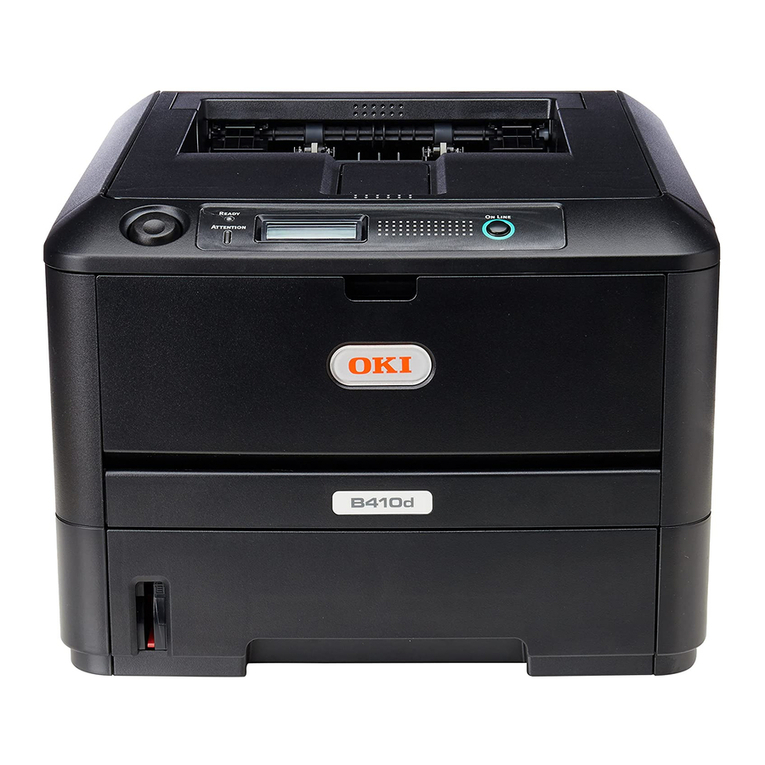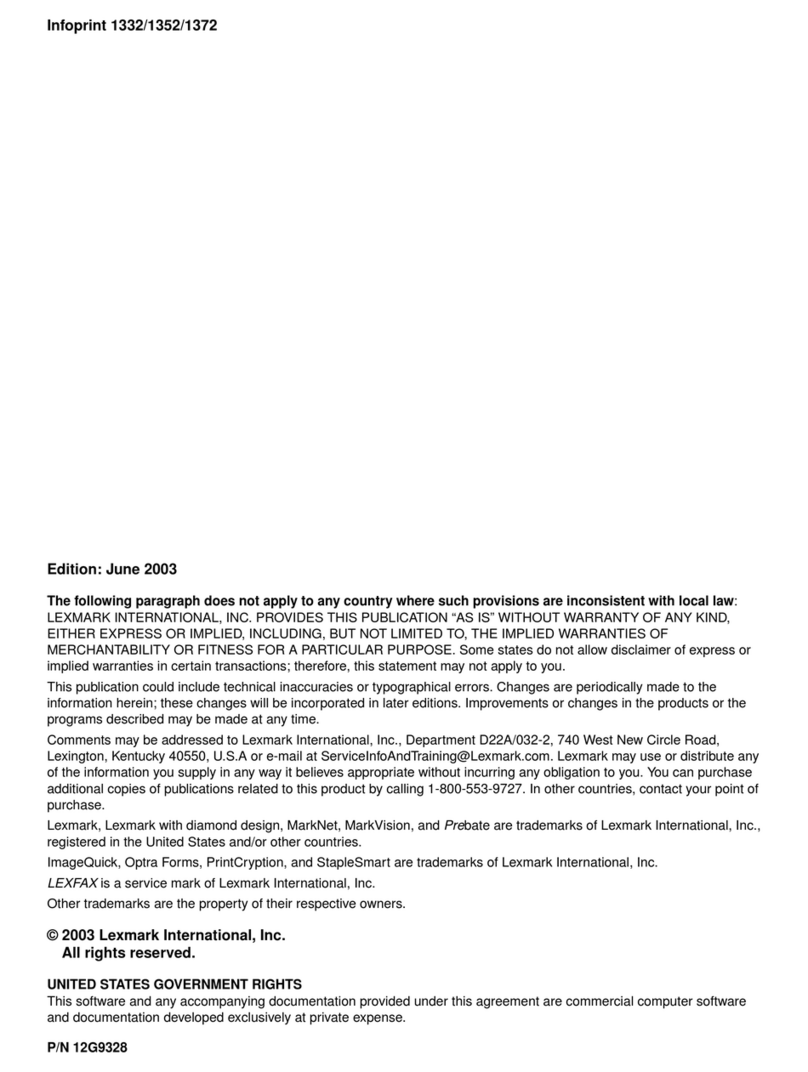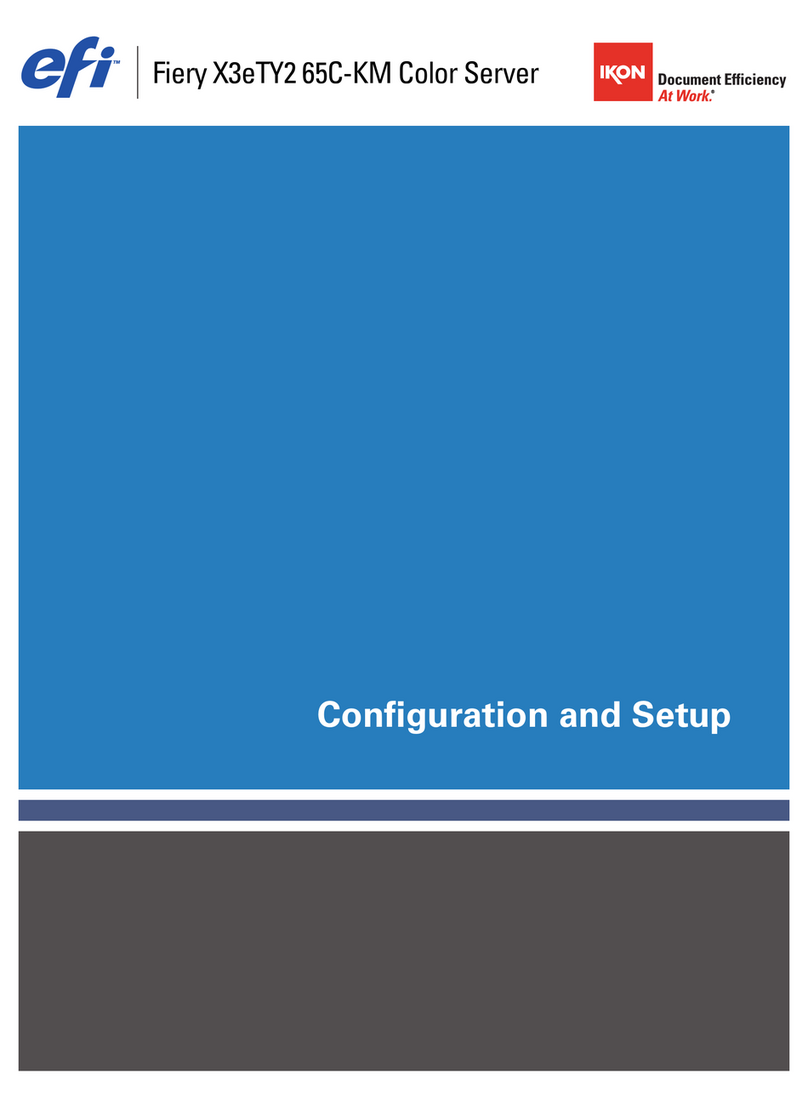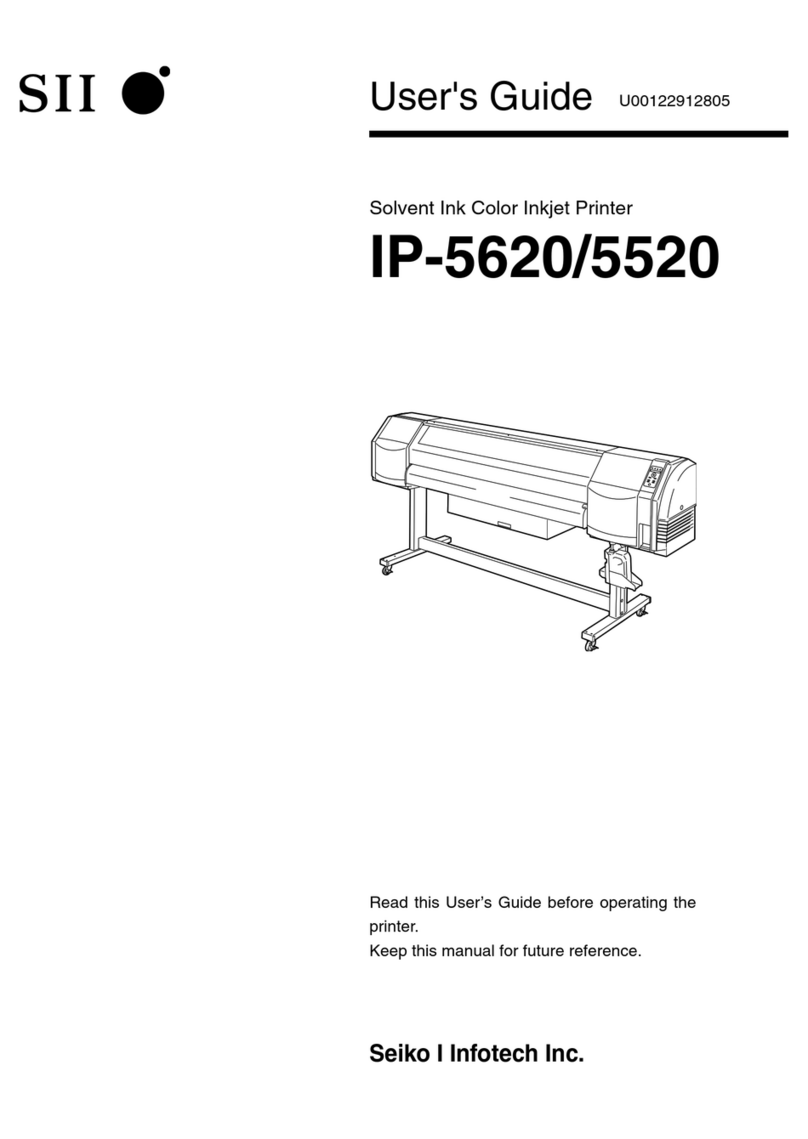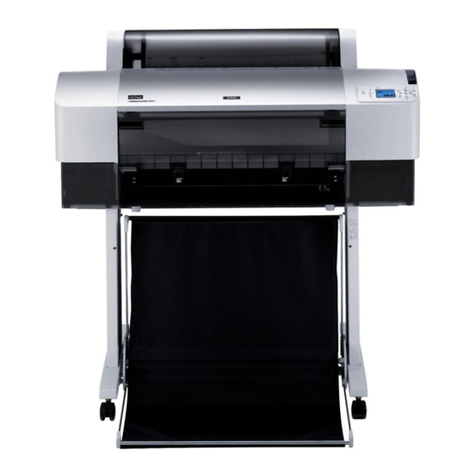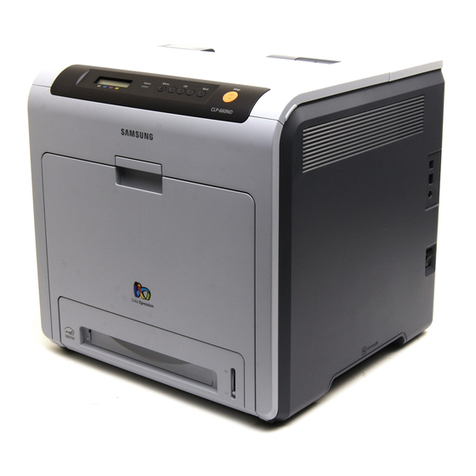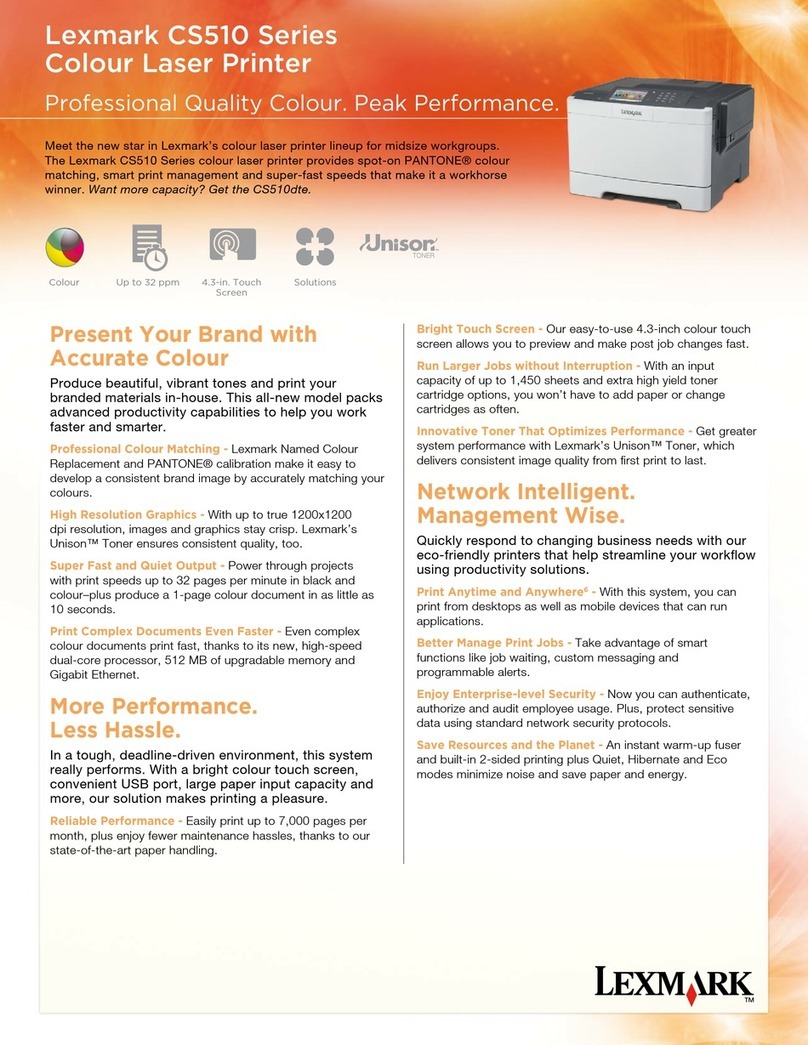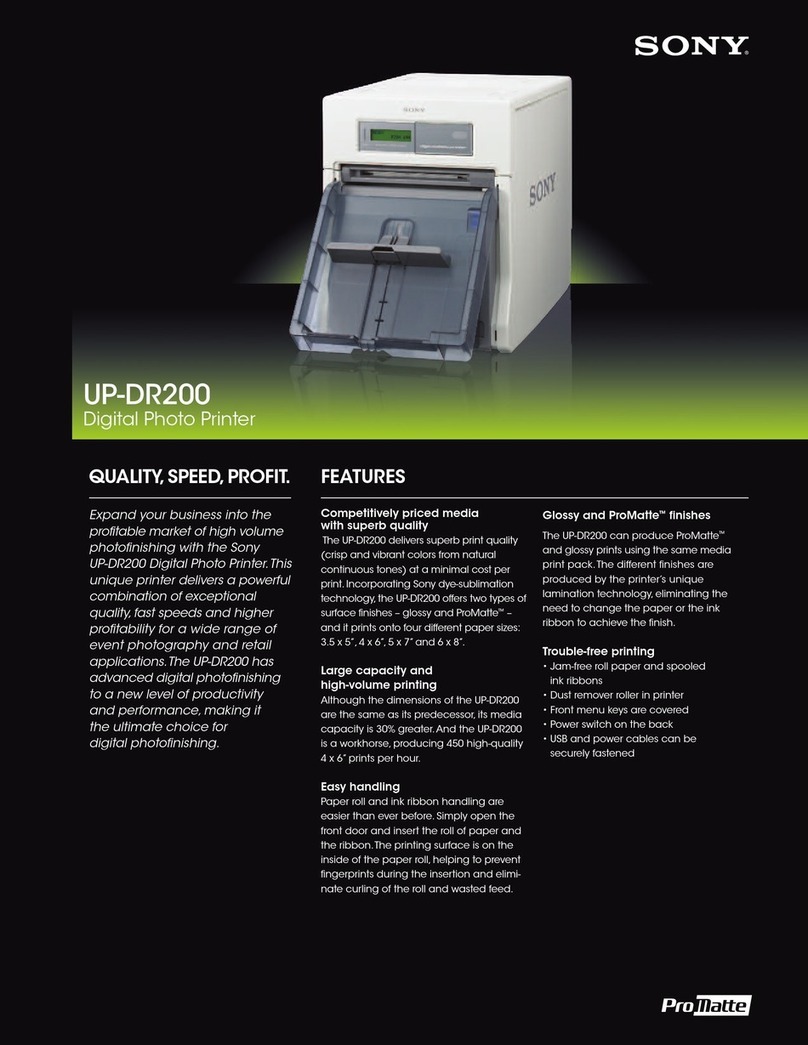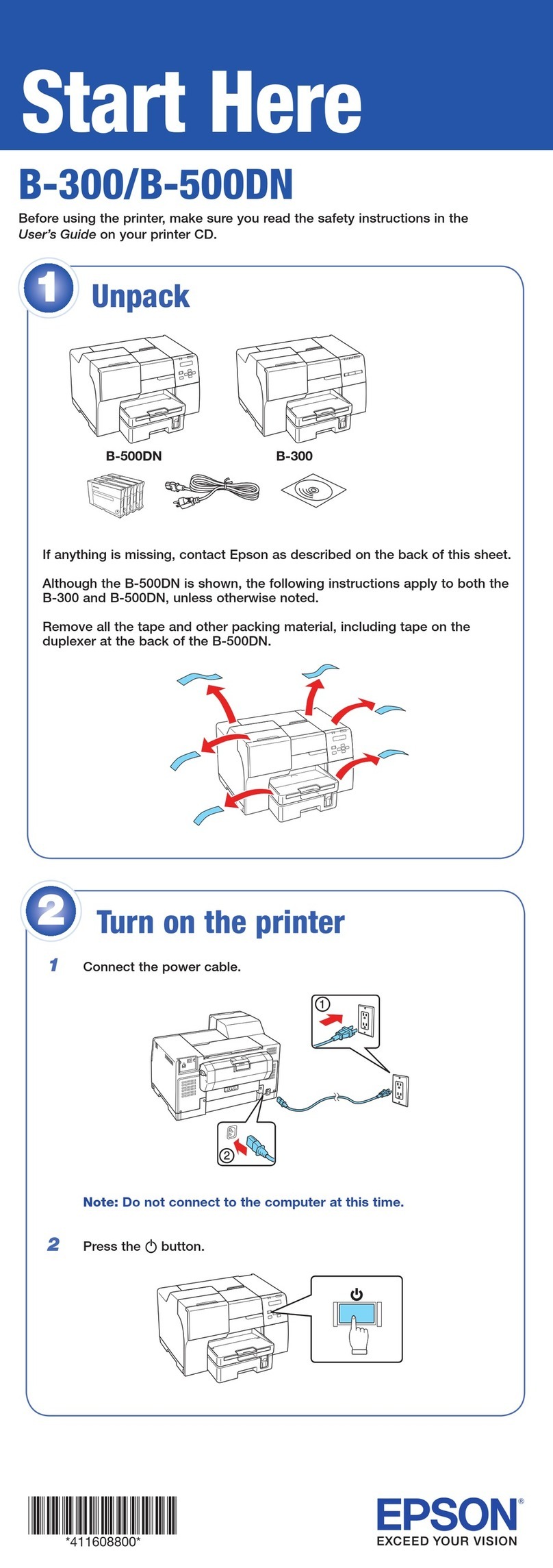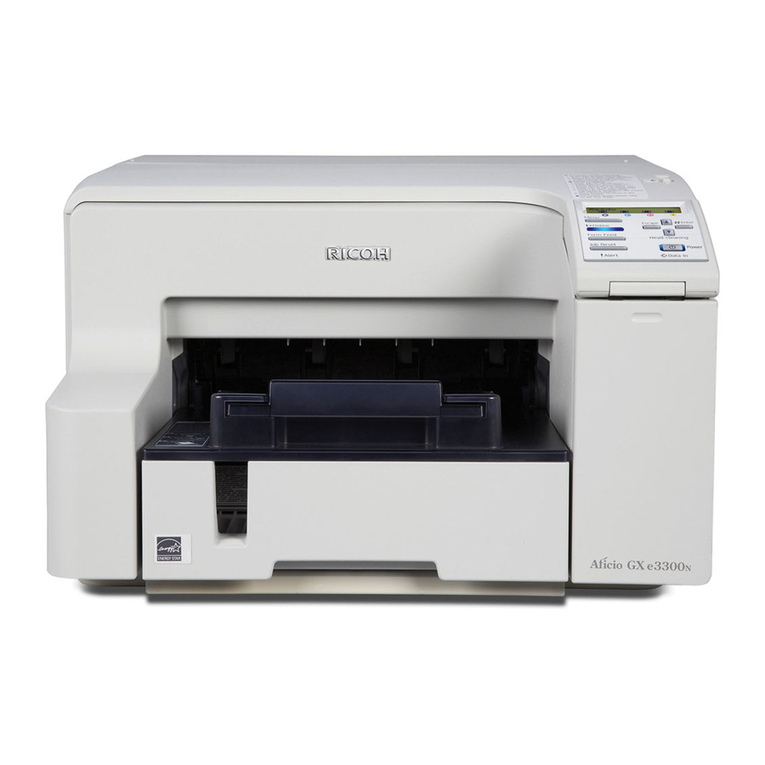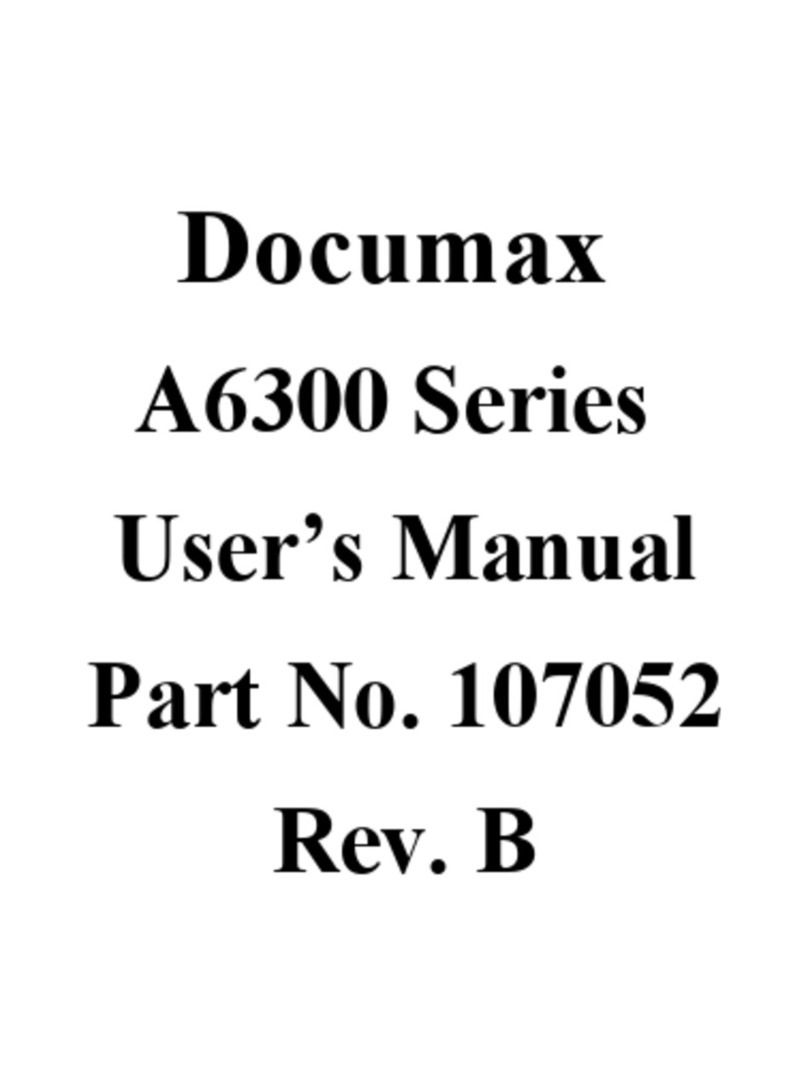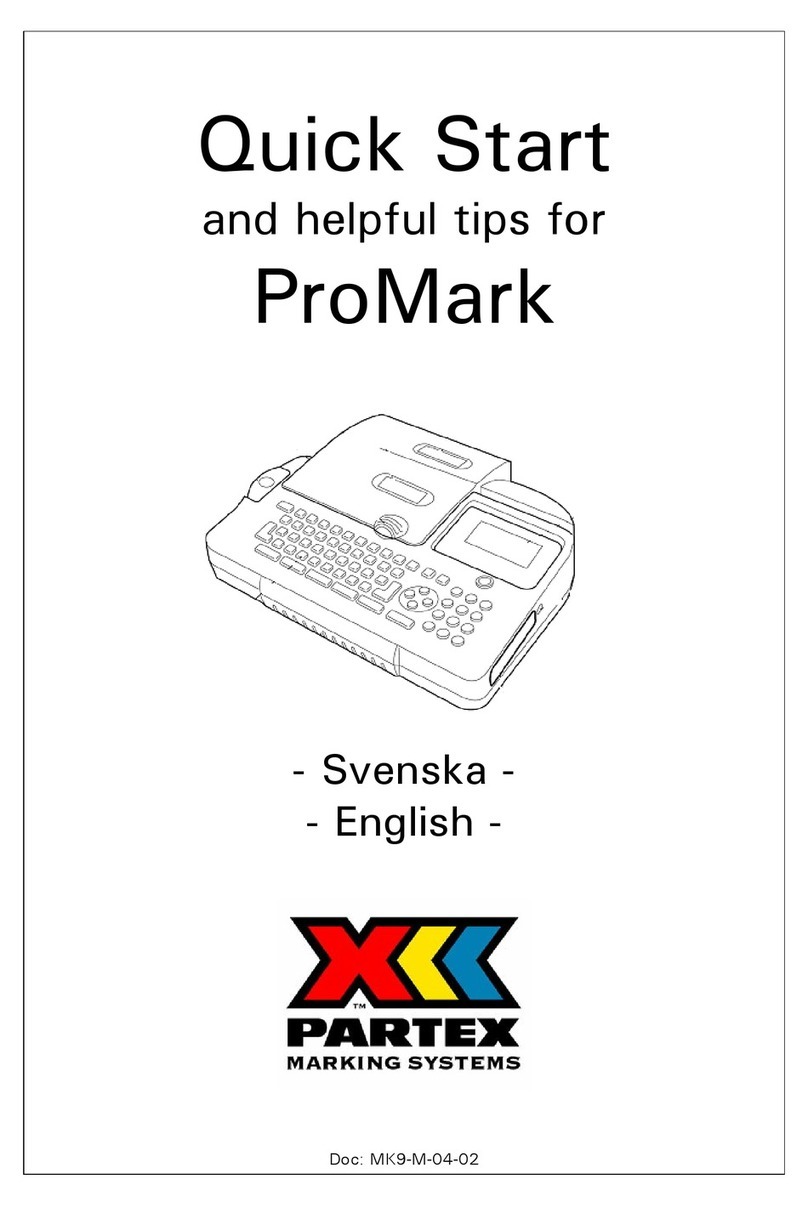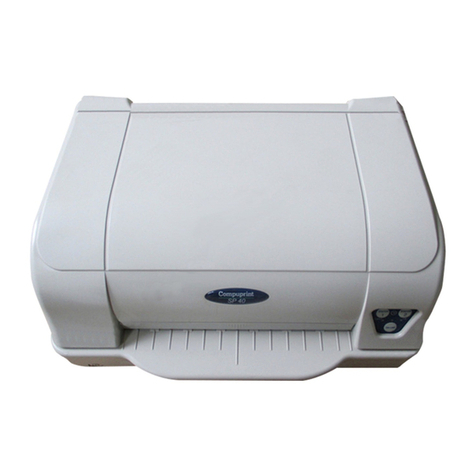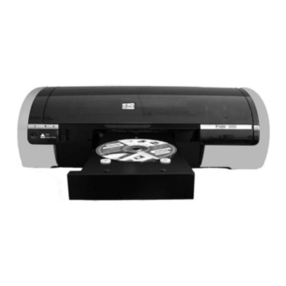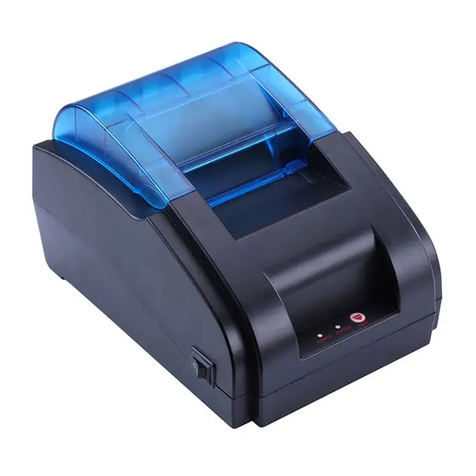Sitten BT850A Operating and maintenance manual

1
80MM THERMAL RECEIPT
PRINTER
PROGRAMMER MANUAL

2
Format Description :
The programming manual command description includes the following sections:
1)[Name]
This is the first part of the command descriptions. ASCII code is given command of the form
and the function overview of command .
2)[Format]
This section uses the ASCII coding form, Hex code form, Decimal code form of three kinds of
formal description of the command. Which part of the range compared to a decimal number no
special instructions, such as in the following example 1 ≤ n ≤ 4, where 1 is a decimal number,
rather than the ASCII code table in "1".
3)[Range]Gives the allowable ranges for the arguments.
4)[Description]Describes the command’s function.
5)[Detail]
The command notice is given. Because commands in different modes, when with different
commands, will lead to mutual influence, and this section gives the details.
6)[Reference]Gives the lists of related commands.
---> ESC SP n :Transmit real-time status
---> [Format] ASCII: ESC SP n
Hex: 1B 20 n
Decimal: 27 32 n
---> [Range] 0 ≤ n≤255
---> [Description] Transmitted in real time specified by the parameter “n” Printer Status:
---> [Detail] •Immediatelyreturns the printer associated status after receiving the command.
---> [Reference]

1
HT
[Name] Horizontal tab
[Format]ASCII HT
Hex 09
Decimal 09
[Decription] Moves the print position to the next horizontal tab position.
[Details]
•This command is ignored unless the next horizontal tab position has been set.
• If the next horizontal tab position exceeds the printing area,
the printer setstheprinting position to [Printing area width + 1].
• Horizontal tab positions are set with ESC D.
• If this command is received when the printing position is at [printing area width
+ 1], the printer executes print buffer-full printing of the current line and
horizontal tab processing from the beginning of the next line.
[Reference]ESCD
LF [Name] Print and line feed
[Format] ASCII LF
Hex 0A
Decimal 10
[Description] Prints the data in the print buffer and feeds one line based on the current linespacing.
[Note] This command sets the print position to the beginning of the line.
[Reference] ESC2,ESC3
DLEDC4nmt
[Name] Real-time pulse generator
[Format] ASCII DLE
DC4
n
m
t
Hex 10 14 n m t
Decimal 16 20 n m t
[Range] n=1,m=0,1
1
≤
t
≤8
[Decription] Output pulse is specified by the parameter t connection pins, “m” show as below:
m
Connect Pins
0
Cash Drawer Connect Pin 2
1
Cash Drawer Connect Pin 5
Pulse high time for[t*100 ms],low time for [t*100
ms]
。
[Details]• When the printer is executing a command to open the cash drawer (ESCp or DELDC4),
the command is ignored.
• In serial mode, the printer immediately after receiving the order.
• In parallel mode, the printer is busy when the command is not executed.
• If the print data same as the command contains data, the data will be used as the command
is executed. The user must take into account this situation.
• Don’t try to insert the command in two or more bytes in the command sequence.
• Even if the printer is set to disabled by the command of ESC = (select peripheral), the
order is still valid.
[Reference] ESCp
ESCSPn
[Name] Setting the right side character spacing
[Format] ASCIIESC SP n
Hex1B 20 n

2
Decimal 27 32 n
[Range] 0≤n≤255
[Description]Setting the right side character spacing for [n¬0.125 mm].
[Note]• For the double-width mode, the right side character spacing is double than the normal
mode. When the character is magnified , the right side character spacing is n times
than the normalmode.
•This command does not affect the setting of Hanzi characters.
• The command to set the value of independent standard mode in each mode.
[Defaults] n=0
ESC!n
[Name]
Select print
mode(s)
[Format]
A
SCIIESC
!
n
Hex 1B 21 n
Decimal
27 33 n
[Range]0≤ n≤ 255
[Description]Selects print mode(s) ,using n as follows:
Bit
OFF/ON
Hex
Decimal
Functions
0
OFF
00 0
Character font
A
(12
¬
24)
。
ON
01 1Character fontB
(9
¬
17)
。
1---
N/A
2---
N/A
3
OFF
00 0
Emphasized mode not selected.
ON
08 8
Emphasized mode selected.
4
OFF
00 0
Double-height mode not selected.
ON
10 16
Double-height mode selected.
5
OFF
00 0
Double-width mode not selected.
ON
20 32
Double-width mode selected.
6---
N/A
7
OFF
00 0
Underline mode not selected.
ON
80 128
Underline mode selected.
[Note]• When both double-height and double-width modes are selected,
quadruple sizecharacters are printed.
• The printer can underline all characters, but can not underline the space set by
HT or 90° clockwise rotated characters.
•
The thickness of the underline is that selected by ESC , regardless of the
character size.
• When some characters in a line are double or more height, all the characters
on the line are aligned at the baseline.
• ESC E can also turn on or off emphasized mode. However, the setting of the
last received command is effective.
• ESC —can also turn on or off underline mode. However, the setting of the last
received command is effective
•GS ! can also select character size. However, the setting of the last received
command is effective.
• Emphasized mode is effective for alphanumeric and Hanzi. All print modes
except emphasized mode is effective only for alphanumeric.
[Defaults] n=0
[Reference] ESC-,ESCE,GS !

3
ESC$nLnH
[Name] Set absolute print position
[Format] ASCIIESC $ nL nH
Hex1B 24 nL nH
Decimal27 36 nL nH
[Range]0≤ nL≤ 255
0≤ nH
≤
255
[Description]Sets the distance from the beginning of the line to the position at
whichsubsequent characters are to be printed.
•
The distance from the beginning of the line to the print position is
[( nL + nH * 256) *(vertical or horizontal motion unit)] inches.
[Note] • Settings outside the specified printable area are ignored.
• In standard mode, the horizontal motion unit ( x) is used.
[Reference] ESC\, GS $, GS \
ESC%n
[Name]Select/cancel user-defined character set
[Format] ASCIIESC % n
Hex 1B 25 n
Decimal 27 37 n
[Range] 0≤ n≤ 255
[Description]Selects or cancels the user-defined character set.
• When the LSB of n is 0, the user-defined character set is canceled.
•When the LSB of n is 1, the user-defined character set is selected.
[Note]When the user-defined character set is canceled,the internal character set is
automatically selected
• n is available only for the least significant bit.
[Defaults] n=0
[Reference] ESC&,ESC?
ESC&yc1c2[x1d1...d(y×x1)].. .[xkd1...d(y×xk)]
[Name] Define user-defined characters
[Format] ASCII ESC & y c1 c2[x1d1...d(y x1)]...[xkd1...d(y
xk)]
Hex 1B 26 yc1 c2[x1d1...d(y x1)]...[xkd1...d(y
xk)]
Decimal 27 38 yc1
c2[x1d1...d(y
x1)]...[xk
d1...d(y
xk)]
[Range] y=3
32 ≤ c1≤ c2≤ 126
0≤ x≤ 12(12×24)
0≤ x≤ 9(9×17)
0≤ d1...d(y× xk)≤ 255
[Description]Defines user-definedcharacters.
•y specifies the number of bytes in the vertical direction.
• c1 specifies the beginning character code for the definition, and c2 specifies the
final code
• x specifies the number of dots in the horizontal direction.
[Note]• The allowable character code range is from ASCII code <20>H to <7E>H (95characters).
•
It is possible to define multiple characters for consecutive character codes.
If only one character is desired, use c1 = c2.
• d is the dot data for the characters. The dot pattern is in the horizontal directionfrom the
left side. Any remaining dots on the right side are blank.
• The data to define a user-defined character is(y×x)bytes.

4
• Set a corresponding bit to 1 to print a dot or 0 to not print a dot.
•
This command can define different user-defined character patterns by each
fonts. To select a font, use ESC !
• A user-defined character and a downloaded bit image cannot be defined
simultaneously. When this command is executed, the downloaded bit image is
cleared.
• The user-defined character definition is cleared when::
1) ESC @ is executed.
2) ESC ? is executed.
3) ESC? is executed
4) The printer is reset or the power is turned off.
• When the user-defined characters are defined in font B (9 ╳17),only the
mostsignificant bit of the 3rd byte of data in vertical direction is effective.
[Defaults] The internal character set
[Reference] ESC%,ESC?
[Example]
•
When font A
(12*24)is selected.
•
When font B
(9
*
17)
is selected.
d1=<0F>Hd4=<30>Hd7=<40>H...
.
d2=<03>Hd5=<80>Hd8=<40>H...
.
d3
=<00>Hd6=<00>Hd9=<20>H...
.

5
d1=<1F>Hd4= <08>Hd7=<10>H...
d2=<FF>Hd5= <08>Hd8=<04>H...
d3=<80>Hd6=<00>Hd9 =<00>H...
ESC*mnLnHd1...dk
[Name] Select bit-image mode
[Format]ASCIIESC
∗
m
nL
nH
d1...dk
Hex
1B
2A m nL nH d1...dk
Decima l
27
42 m nL nH d1...dk
[Range]m=0, 1, 32,33
0≤ nL≤ 255
0≤nH≤ 3

6
0≤ d≤ 255
[Description]Selects a bit-image mode using m for the number of dots specified by nL and nH,as follows:
m
Mode
Vertical Direction
Horizontal Direction
Number of
Dots
DotDensity
DotDensity
Number of Data(K)
08-dot single-density 867.7dpi 101.6dpi nL +nH
∗
256
18-dot double-density 867.7dpi 203.2dpi nL +nH
∗
256
32 24-dot single-density 24 203.2dpi 101.6dpi (nL+
nH
∗
256)
∗
3
33 24-dot double-density 24 203.2dpi 203.2dpi
(
nL
+nH
∗
256)
∗
3
dpi:Print dots per 25.4 mm (1inch)
[Note]
•
If the values of m is out of the specified range, nL and data following are processed
as normal data.
nL and nH represents the horizontal upper figure points, calculated by nL + nH256 points.
•If the bit-image data input exceeds the number of dots to be printed on a line,the
excess data is ignored.
•d indicates the bit-image data. Set a corresponding bit to 1 to print a dot or to 0to
not print a dot.
•If the width of the printing area set by GS L and GS W less than the widthrequired
by the data sent with the ESC * command, the following will beperformed on the line
in question (but the printing cannot exceed the maximumprintable area):
①The width of the printing area is extended to the right to accommodate theamount
of data.
②If step ①does not provide sufficient width for the data, the left margin isreduced
to accommodate the data.For each bit in the single density mode (m = 0, 32) of the
data, the printer prints two points: For double density mode (m = 1,33) of each bit of
data, the printer prints a dot . When calculating the amount of data that can be printed
on one line, they must be considered.
• After printing a bit image, the printer returns to normal data processing mode.
• This command is not affected by print modes (emphasized, double-
strike,underline, character size or white/black reverse printing), except upside-
downprinting mode.
•The relationship between the image data and the dots to be printed is as
follows:
• When 8-dot bit image is selected:

7
•When 24-dot bit image is selected:

8
ESC- n
[Name]
Turn underline
mode on/off
[Format]
ASCII ESC
-
n
Hex 1B 2D
n
Decimal 27 45
n
[Range]0≤ n≤ 2,48≤ n≤ 50
[Description]Turns underline mode on or off, based on the following values of n:
n
Function
0, 48
Turns off underline mode
1, 49
Turns on underline mode (1-dot thick)
2, 50
Turns on underline mode (2-dots thick)
[Note]• The printer can underline all characters (including right-side character spacing),
but cannot underline the space set by HT.
•The printer cannot underline 90° clockwise rotated characters and
white/blackinverted characters.
• When underline mode id turned off bysetting the value of n to 0 or 48,
thefollowing data is not underlined, and the underline thickness set before
themode is turned off does not change. The default underline thickness is
1 dot.
•Changing the character size does not affect the current underline thickness.
• Underline mode can also be turned on or off by using ESC !. Note,
however,that the last received command is effective.
[Defaults] n=0
[Reference] ESC!

9
ESC2
[Name]
Select default line
spacing
[Format]
ASCIIESC 2
Hex
1B 32
Decimal
27 50
[Description]Select default line spacing for3.75mm
(30
¬
0.125mm)
.
[Note]• The line spacing can be set independently in standard mode and in page mode.
[Reference]ESC3
ESC3n
[Name]
Set line spacing
[Format]
ASCIIESC
3
n
Hex 1B 33 n
Decimal
27 51 n
[Range]0≤ n≤ 255
[Description]Set line spacing for[n × 0.125mm].
[Note]• The line spacing can be set independently in standard mode and in page mode.
• In standard mode, the vertical motion unit (y) is used.
[Defaults] n=30
[Reference] ESC2
ESC?n
[Name]Cancel user-defined characters
[Format]ASCIIESC ? n
Hex 1B 3F n
Decimal27 63 n
[Range]32≤ n≤ 126
[Description]Cancel user-defined characters
[Note]•This command cancels the pattern defined for the character code specified byn.
After the user-defined characters is canceled, the corresponding pattern forthe
internal character is printed.
• This command deletes the pattern defined for the specified code in the fontselected
by ESC !.
• If a user-defined character has not been defined for the specified charactercode, the
printer ignores this command.
[Reference]ESC&,ESC%
ESC@
[Name]
Initialize printer
[Format]
ASCII ESC @
Hex
1B 40
Decimal 27 64
[Description] Clears the data in the print buffer and resets the printer mode to the mode thatwas
in effect when the power was turned on.
[Note]• The DIP switch settings are not checked again.
• The data in the receive buffer is not cleared.
• The macro definition is not cleared.

10
ESCBn
t
[Name]Set buzzer
[Format]
ASCII
ESC
B
n
t
Hex 1B 42 n t
Decimal 27 66 n t
[Description]1<=n<=9,1<=t<=9
[Details]The buzzer ring when print the order.
•
n
Refers to the number of buzzer times
•
t
Refers to the buzzer beeps every few hours (t * 100) milliseconds.
ESCDn1...nk NUL
[Name] Set horizontal tab positions
[Format] ASCIIESC D n1...nk NUL
Hex 1B 44 n1...nk 00
Decimal 27 68 n1...nk 0
[Range]1≤ n≤ 255
0≤ k≤ 32
[Description]Set horizontal tab positions。
• nspecifies the column number for setting a horizontal tab position from
thebeginning of the line.
• k indicates the total number of horizontal tab positions to be set.
[Note]
•
The horizontal tab position is stored as a value of [character width * n]measured from
the beginning of the line. The character width includes theright-side character
spacing, and double-width characters are set with twice thewidth of normal
characters
• This command cancels the previous horizontal tab settings.
• When setting n = 8, the print position is moved to column 9 by sending HT.
• Up to 32 tab positions ( k = 32) can be set. Data exceeding 32 tab positions
isprocessed as normal data.
• When [ n] k is less than or equal to the preceding value [ n] k-1, tab setting
isfinished and the following data is processed as normal data.
• ESC D NUL cancels all horizontal tab positions.
•The previously specified horizontal tab positions do not change, even if thecharacter
width changes.
• The character width is memorized for each standard and page mode.
[Defaults]The default tab positions are at intervals of 8 characters (columns 9, 17, 25,...)
forfont A (12 ╳24).
[Reference]HT
ESCEn
[Name] Turn emphasized mode on/off
[Format] ASCII ESC E n
Hex 1B 45 n
Decimal 27 69 n
[Range]0≤ n≤ 255
[Description]Turn emphasized mode on/off。
When the LSB of n is 0, emphasized mode is turnedoff.
When the LSB of n is1, emphasized mode is turned on.
[Note]• Only the least significant bit of n is enabled.
•This command and ESC ! turn on and off emphasized mode in the same way.
Be careful when this command is used with ESC !.
[Defaults] n=0
[Reference] ESC!

11
ESCGn
[Name] Turn on/off double-strike mode
[Format] ASCIIESCG n
Hex 1B 47 n
Decimal27 71 n
[Range]0≤ n≤ 255
[Description]Turn on/off double-strike mode
• When the LSB of n is 0, double-strike mode is turned off.
• When the LSB of n is 1, double-strike mode is turned on.
[Note]Only the lowest bit of n is enabled.
•Printer output is the same in double-strike mode and in emphasized mode.
[Defaults] n=0
[Reference]ESCE
ESCJn
[Name]
Print and feedpaper
[Format]
ASCIIESC
J
n
Hex
1
4A n
Decimal
2
74 n
[Range]0≤ n≤ 255
[Description]Prints the data in the print buffer and feeds the paper [ n * vertical or
horizontalmotion unit] inches.
[Note] • After printing is completed, this command sets the print starting position
to thebeginning of the line.
• The paper feed amount set by this command does not affect the values set byESC 2
or ESC 3.
•In standard mode, the printer uses the vertical motion unit ( y).
ESCMn
[Name]
Select character font
[Format]
ASCII 码ESC
M
n
十六进制码 1B 4D n
十进制码 27 77 n
[Range]
n=0, 1, 48,49
[
Description]
Select character font
[Note]• ESC! can also select the font type. But last received command settings made effective.
[Reference]ESC!
ESCVn
n
Function
0, 48
Character font A (12 * 24) selected.
1, 49
Character font B (9 * 17) selected.

12
[Name]
Turn 90° clockwise rotation mode on/off
[Format]
ASCIIESC Vn
Hex 1B 56 n
Decimal 27 86 n
[Range]0≤ n≤ 1,48≤ n≤ 49
[Description]Turn 90° clockwise rotation mode on/off
n is used as below:
n
Function
0,48 Turns off 90° clockwise rotation mode
1,49 Turns on 90° clockwise rotation mode
[Note]• This command affects printing in standard mode. However,
the setting isalways effective.
• When underline mode is turned on, the printer does not underline 90°
clockwise-rotated.
• Double-width and double-height commands in 90° rotation mode
enlargecharacters in the opposite directions from double-height and double-
widthcommands in normal mode.
[Defaults] n=0
[Reference] ESC!, ESC-
ESC\nLnH
[Name] Set relative print position
[Format] ASCII ESC \ nLnH
Hex 1B 5C nLnH
Decimal 27 92nLnH
[Range]0≤ nL≤ 255
0≤ nH≤ 255
[Description]Sets the print starting position based on the current position by using thehorizontal
or vertical motion unit.
•
This command sets the distance from the current position to [( nL + nH * 256) *
horizontal or vertical motion unit]
[Note]• Any setting that exceeds the printable area is ignored.
•When pitch N is specified to the right:
nL+ nH * 256 = N
When pitch N is specified to the left (the negative direction), use the
complement of 65536.
• In standard mode, the horizontal motion unit is used.
[Reference] ESC$
ESCan
[Name]
Select justification
[Format]
ASCIIESC
a
n
Hex 1B 61 n
Decimal 27 97 n
[Range]0≤ n≤ 2,48≤ n≤ 50
[Description]Aligns all the data in one line to the
specified position
n select the justification as follow:
n
Justification

13
0,48
Left justification
1, 49
Centering
2, 50
Right justification
[Note]• The command is enabled only when processed at the beginning of the line
instandard mode.
• This command executes justification in the printing area.
• This command justifies the space area according to HT, ESC $ or ESC \.
[Defaults] n=0
ESCc5n
[Name] Enable/disable panel buttons
[Format] ASCIIESC c 5 n
Hex 1B 63 35 n
Decimal27 99 53 n
[Range]0≤ n≤ 255
[Description]Enable/disable panel buttons。
• When the LSB of n is 0, the panel buttons are enabled.
• When the LSB of n is 1, the panel buttons are disabled.
[Note]•Only the lowest bit of n is valid.
• When the panel buttons are disabled, none of them are usable when the
printercover is closed.
• In this printer, the panel buttons are the FEED button.
• In the macro ready mode, the FEED button are enabled regardless of thesettings
of this command; however, the paper cannot be fed by using thesebuttons.
[Defaults] n=0
ESCdn
[Name] Print and feed n lines
[Format] ASCIIESC d n
Hex 1B 64 n
Decimal 27 100 n
[Range]0≤ n≤ 255
[Description]Prints the data in the print buffer and feeds n lines.
[Note]• This command sets the print starting position to the beginning of the line.
•This command does not affect the line spacing set by ESC 2 or ESC 3.
•The maximum paper feed amount is 1016 mm (40 inches).
If the paper feedamount ( nx line spacing) of more than 1016 mm (40 inches)
isspecified,Theprinter feeds the paper only 1016 mm (40 inches).
[Reference] ESC2, ESC3
ESCpmt1t2
[Name] Generate pulse
[Format] ASCIIESC p m t1t2
Hex1B 70 m t1t2
Decimal 27 112 m t1t2
[Range]m=0,1,48,49
0≤ t1≤ 255
0≤ t2≤ 255
[Description]Sends a pulse to the
specifiedconnection pins.
On time=t1x2millisecond
Off time=t2x2millisecond

14
m =0/48 Drawer kick-out connector pin 2.
M=1/49 Drawer kick-out connector pin 5.
ESCtn
[Name]
Select character code table
[Format]
ASCIIESC
t
n
Hex 1B 74 n
Decimal 27 116 n
[Range]0≤ n≤ 5,16≤ n≤ 19,n=255
[Description]Selects a page n from the character code table.
[Defaults]n=0
[Reference]Character Code Table
ESC{n
[Name] Turns on/off upside-down printing mode
[Format] ASCIIESC{ n
Hex1B 7Bn
Decimal27 123n
[Range]0≤ n≤ 255
[Description]Turns on/off upside-down printing mode
• When the LSB of n is 0, upside-down printing mode is turned off.
•When the LSB of n is 1, upside-down printing mode is turned on.
[Note]• Only the lowest bit of n is valid.
• This command is enabled only when processed at the beginning of a line instandard
mode.
•
In upside-down printing mode, the printer rotates the line to be printed by 180°and
then prints it.
[Defaults]n=0
[Example]
ESCi [Name] Part Cutter
[Format] ASCII ESCi
Hex 1B 69
Decimal 27 105
[Description]Select Cut mode and half cut
ESCm
[Name] Partial Cut

15
[Format] ASCII ESC m
Hex 1B 6D
Decimal 27 109
[Description]Select Cut mode and half cut
FSpnm
[Name]
Print NV bit image
[Format]
ASCIIFS p
n
m
Hex 1C 70
n
m
Decimal 28 11
n
m
[Range]1≤ n≤ 255
0≤ m≤ 3,48≤ m≤ 51
[Description]Prints a NV bit image n using the mode specified by m.
m
Mode
Vertical DotDensity
Horizontal Dot Density
0,48
Normal
203.2dpi 203.2dpi
1,49
Double-width
203.2dpi 101.6dpi
2,50
Double-height
101.6dpi 203.2dpi
3,51
Quadruple
101.6dpi 101.6dpi
dpi: dots per 25.4 mm {1"}
•n is the number of the NV bit image (defined using the FS q command).
• m specifies the bit image mode.
[Note]
•
NV bit image means a bit image which is defined in a non-volatile memory
byFS q and printed by FS p.
• This command is not effective when the specified NV bit image has not been
defined.
•In standard mode, this command is effective only when there is no data in the print
buffer.
•Thiscommand is not affected by print modes
(emphasized, double-strike,underline,character size, white/black reverse printing,
or 90° rotated characters, etc.),except upside-down printing mode.
• If the printing area width set by GS L and GS W for the NV bit image is
less than onevertical line, the following processing is performed only on
the line in question. However,in NV bit image mode, one vertical line
means 1 dot in normal mode (m=0, 48) and indouble-height mode (m=2,
50), and it means 2 dots in double-width mode (m=1, 49) andin quadruple
mode(m=3, 51).
①The printing area width is extended to the right in NV bit image mode up to
one linevertically. In this case, printing does not exceed the printable area.
②If the printing area width cannot be extended by one line vertically, the left
margin isreduced to accommodate one line vertically.
•If the downloaded bit-image to be printed exceeds one line, the excess data is
notprinted.
• This command feeds dots (for the height n of the NV bit-image) in normal
anddouble-widthmodes, and (for the height n × 2 of the NV bit-image) in
double-height andquadruple modes,regardless of the line spacing specified by
ESC 2 or ESC 3.
•After printing the bit image, this command sets the print position to the beginning
of thelineand processes the data that follows as normal data.
[Reference] ESC*, FS q, GS /, GS v0
FSqn[xLxHyL yHd1...dk]1... [xLxHyLyHd1...dk]n

16
[Name]
Define NV bit image
[Format]
ASCII FS
q
n
[xL xH yL yHd1...dk]1...[xLxH yLyH
d1...dk]n
Hex 1C 71n [xLxHyLyHd1...dk]1...[xLxHyLyH
d1...dk]n
Decimal 28 113n [xLxHyLyHd1...dk]1...[xLxHyLyH
d1...dk]n
[Range]1≤ n≤ 255
0≤ xL≤ 255
0≤ xH≤ 3(当1≤ (xL+ xH× 256)≤ 1023
0≤ yL≤ 255
0≤ yH≤ 1(当1≤ (yL+ yH× 256)≤ 288
0≤ d≤ 255
k=(xL+ xH× 256)× (yL+ yH× 256)× 8
Total defined data area =192K bytes
[Description]Define the NV bit image specified by n .
•n specifies the number of the defined NV bit image.
•xL, xH specifies (xL + xH ╳
256) ╳ 8 dots in
bitimage you are defining.
•yL, yH specifies (yL + yH ╳
256) ╳ 8 dots in
imageyou are defining.
[Note]• Frequently write command may be damaged NV memory. Therefore, it is
recommended to perform no more than 10 times a day, write the NV memory.
• After put an image into NV memory process, the printer performs a hardware reset
the user-defined characters, download bitmap and macros should be defined after
the completion of the command. Printer Clear receive and print buffer and resets
when power efficient model. At this time switch is DIP check again. (Does not
support hardware reset interface)
• This command cancels all been defined with this command NV bitmap.
•From the beginning of the processing of this command till the finish of
hardwarereset,mechanical operations (including initializing the position of the
printer head whenthe cover is open, paper feeding by using the FEED button,
etc.) cannot be performed.
• During processing this command, the printer is in BUSY when writing the data
to the NV user memory and stops receiving data. Therefore it is prohibit ted to
transmit the data including the real-time commands during the execution of this
command。
• NV bit image means a bit image which is defined in a non-volatile memory by FS q
andprinted by FS p.
•In standard mode, this command is effective only when processed at the beginning
ofthe line.
• This command is effective when 7 bytes <FS yH> is processed as a normal value.
•
When the amount of data exceeds the capacity left in the range defined by xL, xH,
yL,yH, the printer processes xL, xH, yL, yH out of the defined range.
•In the first group of NV bit images, when any of the parameters xL, xH, yL, yH is
out of thedefinition range, this command is disabled.
•
In groups of NV bit images other than the first one, when the printer processes xL,
xH, yL,yH out of the defined range, it stops processing this command and starts
writing into theNV images. At this time, NV bit images that haven¡¯t been
defined are disabled(undefined), but any NV bit images before that are enabled.
•The d indicates the definition data. In data (d) a 1 bit specifies a dot to be printed
and a 0bit specifies a dot not to be printed.
• This command defines n as the number of a NV bit image. Numbers rise in order
from NVbit image 01H. Therefore, the first data group [xL xH yL yH d1...dk]
is NV bit image 01H,and the last data group [xL xH yL yH d1...dk] is NV bit
image n. The total agrees with thenumber of NV bit images specified by
command FS p.

17
• A definition data of a NV bit image consists of [xL xH yL yH d1...dk]. Therefore,
when onlyone NV bit image is defined n=1, the printer processes a data group
[xL xH yL yHd1...dk] once. The printer uses ([data: (xL + xH ╳ 2 5 6 ) ╳ (y L +
yH ╳
256) ╳ 8]+ [header :4])bytes of N V m em ory.
• The definition area in this printer is a maximum of 192K bytes. This
commandcan define several NV bit images, but cannot define a bit image data
whose totalcapacity [bit image data + header] exceeds 192K bytes.
•Even setting the ASB, during the processing of the commandthe printer is not
transmitted ASB status or execution status detection.
•When this command is received during macro definition, the printer ends
macrodefinition,and begins performing this command.
•Once a NV bit image is defined, it is not erased by performing ESC @, reset, and
poweroff.
•
This command performs only definition of a NV bit image and does not
performprinting.Printing of the NV bit image is performed by the FS p
command.
[Reference] FS p
GS!n

18
[Name]
Set character size
[Format]
ASCIIGS
!
n
Hex 1D 21
n
Decimal 29 33
n
[Range]0≤n≤ 255
(1≤vertical number of times≤8, 1 ≤horizontal number of times ≤8)
[Description]Selects the character height using bits 0 to 2 and selects the character width
usingbits 4 to 7, as follows:
Bit
OFF/ON
Hex
Decimal
Function
0
Character height selection. See Table 2.
1
2
3
4
Character width selection. See Table 1.
5
6
7
Table1:Character width selection Table 2:Character height selection
Hex Decimal Width
00 01(Normal)
10 16 2(Double-width)
20 32 3
30 48 4
40 64 5
50 80 6
60 96 7
70 112 8
[Note]• This command is all characters (alphanumeric and Kanji) effective except for
HRI characters.
•If n is outside of the defined range, this command is ignored.
•In standard mode, the vertical direction is the paper feed direction, and
thehorizontal direction is perpendicular to the paper feed direction.
However,when character orientation changes in 90° clockwise-rotation mode,
therelationship between vertical and horizontal directions is reversed.
• When characters are enlarged with different sizes on one line, all the
characters on the line are aligned at the baseline.
• The ESC ! command can also turn double-width and double-height modes
onor off. However, the setting of the last received command is effective.
[Defaults] n=0
[Reference] ESC!
GSBn
[Name] Turn white/black reverse printing mode
[Format] ASCIIGS B n
Hex 1D 42 n
Decimal 2966 n
[Range]0≤ n≤ 255
Hex Decimal Height
00 01(Normal)
01 01
2(
Double-height
)
02 02 3
03 03 4
04 04 5
05 05 6
06 06 7
07 07 8
Table of contents
Other Sitten Printer manuals

